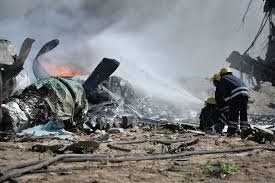Tragedy Strikes at Sardar Vallabhbhai Patel International Airport
In a devastating incident that has sent shockwaves across the aviation sector, Air India Flight AI‑171—a Boeing 787 Dreamliner bound for London Heathrow—crashed shortly after takeoff from Ahmedabad’s Sardar Vallabhbhai Patel International Airport in the early hours of June 12, 2025. The aircraft, carrying over 200 passengers and crew members, suffered catastrophic failure within minutes of ascent, marking India’s first fatal accident involving a Boeing 787.
The aircraft went down in an open area adjacent to the airport perimeter, catching fire upon impact. While an exact casualty count is still being verified, initial reports confirm dozens feared dead, with emergency personnel working through the wreckage. Local authorities and airport officials have declared the area a restricted rescue zone as search and recovery operations continue.
Timeline of the Crash: What We Know So Far
The incident unfolded rapidly after the aircraft’s 3:20 am departure:
- 3:18 AM: Flight AI‑171 received clearance for takeoff.
- 3:22 AM: The pilot reportedly communicated engine irregularities and requested immediate return.
- 3:24 AM: Radar contact lost.
- 3:26 AM: A fireball was witnessed near a boundary area north of the runway.
- 3:35 AM onwards: Fire, police, and medical teams began rescue and containment operations.
Survivor accounts indicate the aircraft attempted a turnback maneuver before the crash. Black box data, now recovered, will provide a definitive answer.
Aircraft Profile: Boeing 787 Dreamliner Under Scrutiny
Flight AI‑171 was operated using a Boeing 787‑8, introduced to Air India’s fleet in 2013. Known for its fuel efficiency and advanced avionics, the Dreamliner has had a strong safety record globally. However, it has also faced recurring concerns related to battery fires, fuselage fatigue, and more recently, turbofan reliability issues in some international fleets.
This incident marks the first hull loss—a total write-off of the airframe—for any 787 in India and potentially the first crash globally involving fatalities since the aircraft’s commercial debut.
Immediate Rescue and Emergency Measures
Ahmedabad authorities activated a Level-3 emergency protocol, deploying:
- Multiple fire brigades
- State disaster response teams
- Specialized burn units at Civil Hospital and Sterling Hospital
- Helpline numbers for families and next of kin
The Gujarat Chief Minister’s Office and DGCA have both confirmed that rescue operations remain ongoing, with identification and recovery continuing through the day.
Air India has issued a preliminary statement expressing condolences and promising full cooperation with investigation agencies. They have also activated their emergency response protocol, including international coordination with Heathrow authorities, given the aircraft’s destination.
He Walked Out of Fire: The Sole Survivor of Air India Flight AI-171 Tells His Story
National and International Investigation Begins
The Directorate General of Civil Aviation (DGCA) has formally launched a probe into the incident. Additionally:
- Boeing is dispatching technical teams from its global support division.
- The US National Transportation Safety Board (NTSB) will participate, as required by international aviation protocols.
- The UK’s Civil Aviation Authority (CAA) is involved due to the destination of the flight.
- Flight data and cockpit voice recorders (black boxes) have been recovered and are en route to Delhi for analysis.
The central government has asked for a preliminary inquiry report within 10 days and a full-scale review of Air India’s 787 maintenance logs, pilot rosters, and flight documentation.
A National Shock: Public and Political Reaction
Political leaders across party lines have expressed deep concern and solidarity. Prime Minister Narendra Modi, in a post on X (formerly Twitter), wrote:
“Deeply pained by the tragic crash of AI-171. Rescue teams are working tirelessly. My thoughts are with the families of those affected.”
Air India’s parent group, Tata Sons, has confirmed it will provide emergency support, family assistance, and grief counselling.
Nationwide Operational Impact: Flight Disruptions and Cancellations
In the immediate aftermath of the Air India AI‑171 crash, aviation operations across Ahmedabad, Delhi, and Mumbai have been significantly disrupted, with ripple effects across the national and international network. The Directorate General of Civil Aviation (DGCA) has initiated a temporary suspension of select Dreamliner operations pending preliminary checks.
Key disruptions include:
- Air India Dreamliner fleet to undergo urgent inspections over 72 hours
- London-bound flights from Ahmedabad, Delhi, and Mumbai facing cancellations or rerouting
- Sardar Vallabhbhai Patel International Airport partially shut for commercial operations till 6 PM IST, June 13
- Emergency slot rescheduling issued for airlines operating widebody aircraft
Passengers have been advised to check with their carriers before traveling to the airport. Flight AI‑173 (Delhi–London) and AI‑169 (Mumbai–London) have been delayed due to pilot crew reallocation and aircraft substitution.
Safety Protocol Overhaul: DGCA Orders Full Fleet Audit
The DGCA has ordered an immediate audit of all Boeing 787 aircraft in India, particularly focusing on:
- Engine health monitoring systems
- Avionics software versions
- Maintenance logs of the last 30 days
- Air India pilot flight duty records
This marks one of the most aggressive regulatory interventions in recent memory, with full cooperation expected from the Ministry of Civil Aviation, Boeing, and airline operators.
Industry experts note that such audits can take 1–2 weeks, affecting long-haul schedules and increasing passenger backlog on transcontinental routes.
Spotlight on Air India: Past Incidents and Present Scrutiny
Air India, now under the Tata Group, has been under active modernization with a massive fleet acquisition plan, pilot recruitment drives, and a rebranding effort. However, this incident has placed the airline under the scanner once again.
In the past 18 months, the carrier has reported:
- Minor technical diversions involving Dreamliners in Mumbai and Frankfurt
- Grounding of certain aircraft for engine wear and autopilot anomalies
While no recent serious incident matched the scale of AI‑171, the crash now raises questions about quality control, crew alertness, and vendor accountability.
Tata Group has stated that a dedicated crisis cell is operating 24/7, and a full independent safety review will be undertaken alongside government probes.
Industry Repercussions: Trust, Insurance, and Fleet Planning
The impact of this tragedy is likely to ripple beyond Air India:
- Insurance liabilities are estimated to run into hundreds of crores, triggering fresh negotiations with international reinsurers.
- Fleet planning across Indian carriers may shift, with greater emphasis on Airbus A350s and Boeing 777s in near-term deployments.
- Passenger trust, especially for long-haul Indian-origin travelers, could temporarily decline—impacting summer travel to Europe and North America.
Aviation analysts have suggested that this incident will push for greater transparency in maintenance records, and real-time engine data sharing between manufacturers and airline operators.
Moving Forward: A Moment of Reckoning for Indian Aviation
The Air India AI‑171 tragedy is not just a safety event—it is a turning point. As India emerges as one of the world’s fastest-growing aviation markets, this disaster exposes the fragile intersections of rapid expansion, aging fleets, and legacy oversight mechanisms.
What lies ahead includes:
- Stricter flight safety checks
- Faster modernization of regulatory infrastructure
- Possible international collaboration on pilot training standards
If the investigations yield systemic lapses, we may see a major shift in how Indian carriers manage fleet integrity, risk, and accountability.
But at the core, remains the human toll—families who lost loved ones, a nation mourning, and an industry reflecting on the cost of progress when safety fails to keep pace.

